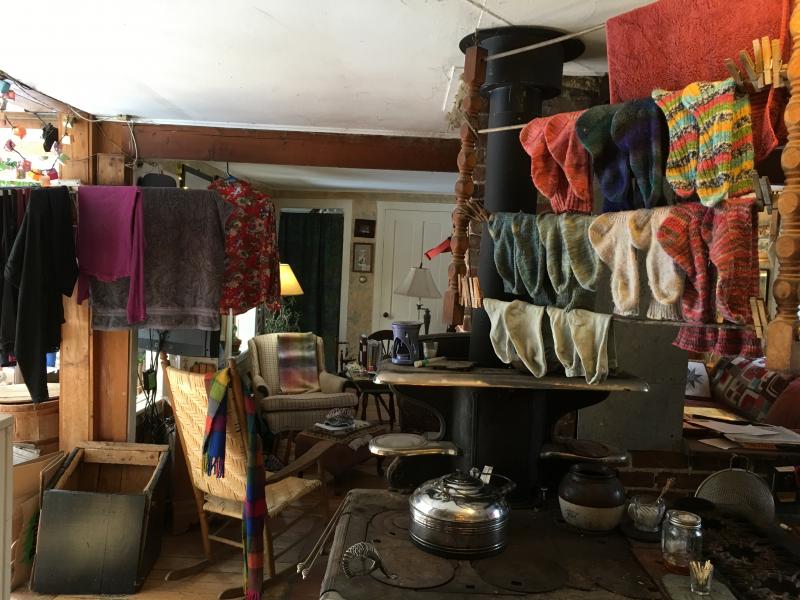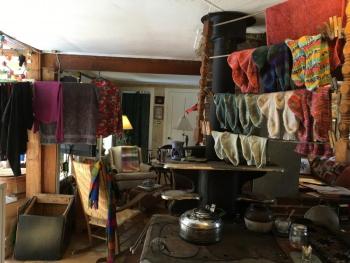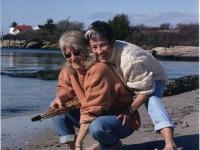This Week in Lincolnville: Half your Hay and Half your Wood
Groundhog Day, the midpoint between the winter solstice and the spring equinox; we’re halfway there on our annual trek through winter. I’m afraid the woodshed here at Sleepy Hollow is looking pretty bare, and we stopped taking inventory of the hayloft 15 years ago when our last cow, and then pony departed. This has been a typical winter if I’m remembering right, with temperature swings bringing snow one day, rain the next, ice underfoot one day, slush the next. Somewhere along the way there’s a thaw – the January thaw we used to call it, when green grass shows itself and hope springs in the human breast. But now that the climate is no longer predictable, it can come any month – or every month. We're still waiting for it this year.
Winter has a lot to do with memory. Didn’t winter used to clamp down around Thanksgiving and only relent just before Easter? Wasn’t it months before we saw bare ground? Green grass? Never. I have photos of this house buried under a couple of feet of snow, the mailbox invisible under the drifts, huge icicles hanging off the eaves. Of course, there are no photos of the kind of slushy mess I walked through this morning, yet there must have been plenty of that.
CALENDAR
MONDAY, Feb. 4
Library open for quiet work, 9 a.m.-1 p.m.
School Committee meets, 6 p.m., Room C-1, LCS
TUESDAY, Feb. 5
Good News Club, 3:15 p.m., LCS
Knitting Workshop, 4 - 6 p.m., Library
PTO Fundraiser, Flatbread Pizza, Rockport
WEDNESDAY, Feb. 6
Watercolor journaling, 4-6 p.m., Library
Illustrated talk on the Azores and Canary Islands, 7 p.m., LibraryTHURSDAY, Feb. 7
Soup Café, Noon-1 p.m., Community Building, 18 Searsmont Road
Inland Waterway Mooring Committee, 6:15 p.m., Town Office
EVERY WEEK
AA meetings, Tuesdays & Fridays at 12:15 p.m., Wednesdays & Sundays at 6 p.m., United Christian Church
Lincolnville Community Library, open Tuesdays 4-7, Wednesdays, 2-7, Fridays and Saturdays, 9 a.m.-noon. For information call 706-3896.
Soup Café, every Thursday, noon—1p.m., Community Building, Sponsored by United Christian Church. Free, though donations to the Community Building are appreciated
Schoolhouse Museum open by appointment, 789-5984.
Bayshore Baptist Church, Sunday School for all ages, 9:30 a.m., Worship Service at 11 a.m., Atlantic Highway
United Christian Church, Worship Service 9:30 a.m., Children’s Church during service, 18 Searsmont Road
COMING UP
Feb. 11: Red Cross Blood Drive, Community Building
Feb. 13: Library program: Half of Every Couple
What we did have was snow deep enough for cross-country skiing and for snowshoes. So far this winter hasn’t obliged. A few inches at a time, then rain, then ice, then a few more inches, then slush. More importantly, for many of our neighbors, the lack of snow has meant a lack of income. Without driveways and private roads to plow there’s no money coming in for those who plan on plowing to carry them through to warmer weather work.
Meanwhile, a full complement of gear piles up by the door: ice creepers, snow boots, walking stick, raincoat, insulated gloves, bucket of salt, snow shovel, preparations for any eventuality. We who spend our days in drafty houses or outdoors have to dress for the cold, starting with today’s version of long underwear.
Readers of regional memoirs have heard of union suits, a full body affair with a drop seat flap, made of wool that itched like crazy and that supposedly you put on in November and didn’t take off until April. Now we can choose thin, silky-feeling leggings or soft cotton long johns, along with t-shirts or tank tops, worn underneath flannel shirts, fleece vests and jeans. The effect is the same – the Pillsbury doughboy look – but at least we’re not itching.
One by one we watch neighbors take off for warmer latitudes. The pews at church thin out, houses look shuttered, closed up. One snowbird I’m in touch with bemoans this winter’s chilly Florida temperatures – 50 degrees – humph. Happy faces, those very neighbors, smile at us on Facebook, sunning themselves in Florida, the Caribbean, Belize for goodness sakes. Yes, Dorothee and Rob, I saw you there!
Birds migrate south. Bears hibernate. Frogs burrow into the mud. Mainers go to Florida. Who, in Lincolnville, thought of that first? Let’s imagine it was the Hardys, a large clan living on the outskirts of Youngtown, (which, of course, got its name from the Young clan); there is no Hardytown. Here’s their story:
Carrie Young married Robert Hardy in 1880 when she was 20 and he 22. Their children arrived, one every two years or so, until there were nine. Fred E. was born in 1881, Blanche M. in 1883, Robert P. (Bob) in 1885, Ina B. in 1889, Herbert E. in 1890, Jennie C. in 1892, Carl R. in 1895, Hetty O. in 1897, and Si in 1900. The family’s farm [456 Youngtown Road] like most of Lincolnville’s farms at the time, provided most of what they needed. In addition, Robert Hardy was a clever man who found ways to use his large family to advantage.
Each spring, starting in about 1907, Robert would buy a herd of cows and drive them from Youngtown Road over the old mountain roads, and on down to Sagamore Farm [Camden Hills State Park entrance]. He initially leased the famous showplace farm from Edward Stearns, son of J.B. Stearns, and later from the Heublein Corporation. Here he had the use of Sagamore’s pastures and hayfields, as well as the modern and efficient barn. It was the perfect place to put his grown children and their spouses to work. In addition to his sons Fred, Herbert, Carl, Robert and Si, there were at times three hired men as well. The house, which hadn’t been kept up nearly as well as the showplace barns, was a duplex. A pair of elderly maiden women, the Rapp sisters lived in the other half; the Hardy children later recalled that they weren’t very friendly, perhaps not pleased at having such a big family living next door.
Camden was only a mile away, with its population of merchants, millworkers, laborers as well as wealthy summer residents, all customers for the farm’s products, which Robert peddled on a regular route. At the end of the season, he would sell the herd he’d bought in the spring and go to Florida. Winters he left crews of men and teams of horses at work cutting kilnwood for the Rockport lime industry in the forest behind the farm.
The number of cows milked at Sagamore varies from around fifty in 1899 to either seventy or a hundred and twenty-five, depending on which Hardy’s memory is accurate. At any rate, the cows were all milked by hand, and according to George Hardy, his uncle Si could milk three at once! Robert’s route took him through Camden; his old horse, Jennie knew the route, stopping at each house along the way. When Jennie finally died Robert got a Model T; the trouble was, Robert didn’t know the route as well as the horse did, and the car didn’t know where to stop.
Based on that information which was gleaned from interviews from various Hardy descendants, I wrote the following, imagining the annual trip over the mountain with that herd of cows:
The black flies were coming on thick now that it was past noon; Robert Hardy squinted at the sun overhead. As soon as they got the herd past Zeke’s Lookout they might start to catch a breeze off the Bay. That’d help. Otherwise this whole day was going to be miserable, leading twenty cows over the rough road that led between his place on Youngtown Road and Sagamore Farm on the Atlantic Highway leading out of Camden.
The morning had been a rout, cows going every which way, the boys chasing first this one, then that one, and him in the middle bellowing orders. He didn’t know which drove him crazier, the cows or his sons. You’d think young men raised around cattle all their lives would know better than to get behind a spooked cow and try to run her to ground.
But finally everyone got the running out of their system, leaving both cows and men exhausted. When at last the herd was stumbling along more or less in line along the road, Robert thought he caught a few grumbles between the older fellows—Fred and Blanche’s husband, Winfield. Probably something along the lines of “what’s the old man thinking of?”
He’d let them wonder. He knew what he was doing. Since he’d signed the lease with the owners, Sagamore was finally his, or good as. Now he could farm the place just as he pleased. All those years of managing it as a showplace, well he was glad to be done with that.
It made sense to run it only during the summer months when Camden’s population swelled with wealthy city folks all needing dairy products. In the fall he’d just sell off the herd to a cattle dealer, and take his family to Florida for the winter. Now there was a clever plan!
Robert walked briskly along at the head of the line of cows, trusting that the boys were keeping things under better control now. He hoped Carrie hadn’t lingered this morning after he left but got the younger children loaded onto the wagon and headed to Camden early. They were taking the old Turnpike road along the lake so she could get the rest of her supplies in town. He’d had a barrel of flour delivered to the kitchen at Sagamore just yesterday, but there were other things she said she had to pick up.
from Staying Put in Lincolnville, Maine 1900-1950
In November 1921 Robert Hardy, one of the nine children mentioned above, and his wife, Gladys traveled to Lakeland, Florida in a Model T. What transpired on that trip became part of local legend, with the definition of local confined to one small neighborhood, Youngtown Road, Lincolnville.
Robert Hardy’s family in 1921 consisted of his wife, Gladys and nine-year-old son, Newman; a little girl, Roberta was born some years later. Newman Hardy was a familiar character around town, even when I first moved to Lincolnville in 1970, a somewhat odd fellow who used to walk the long road along Megunticook to Camden for his groceries, who could swim underwater seemingly forever, even would chop holes in the ice for a winter swim. The bright little boy of 1921 had experienced an illness as a young teen that left him with some disabilities; he never drove or married or even moved from the house of his birth, living out his life there until his death in 1993 at 81.
Several years ago Rosey Gerry wrote and produced a play based on the Hardys’ annual trip to Florida. He called it “Three Weeks and Twenty-six Flats”, the story of the 1921 trip.
How do these stories survive?
This one survived because Rosey, a small boy growing up on that road did what small boys (and girls, too) have always done – listened to his elders tell stories. Rosey has a unique ability to retell the story in a way that makes the listener sure he’s hearing it just as it was told some fifty years ago by an old farmer leaning on the hood of his pickup, relishing every detail of his neighbor’s folly.
Ever since, Rosey’s been entertaining anyone who will listen, falling into the lingo, the nuance of voice, the body language of those long-gone men and women of his Youngtown Road neighborhood. He took this simple narrative of Robert and Gladys Hardy’s travails on the road to Florida, and turned it into a play, actually, an old-time radio play, complete with sound effects and the dramatic emphasis of an organ playing in the background. It’s been performed at least twice, once at the Owls Head Transportation Museum where actors (Kerry Hardy played his great-uncle Robert and I was Gladys) had a real, live Model T as a prop, and another time as a radio play presented at the Lincolnville Boat Club with a wonderful photo slide show accompaniment.
I think it’s time to revive Three Weeks and Twenty-six Flats, to revisit our snowbird roots. What do you think, Rosey?
School
Congratulations to the following January Students of the Month: Kindergarten, Indra O’Donnell; First Grade, Maggie Feeney and Anderson Janaitis; Second Grade, Ethan Fowler and Pearl Yetman; Third Grade, Amelia Davis and Acacia Hartley; Fourth Grade, Zev Whitcomb and Maddy Place; Fifth Grade, Awnin Oxley and Mickey Nowell; Sixth Grade, Skyla Dyer; Seventh Grade, Roo Boetsch; Eighth Grade, Izzy Powers.
Donations of mittens and gloves for kids to borrow while at school are needed. Bring them to school secretary, Marie Pierce.
Library
Librarian Elizabeth Eudy has this week’s upcoming events:
“This Monday morning the Library will be open for Quiet Hours from 9-1 for those who wish to come do some quiet work or reading. Bring your computer, or use one of ours, and take advantage of the Library’s free high-speed internet service.
“Tuesday, February 5 Knitting Workshop will beheld from 4-6. Experienced knitters will be on hand to help knitters at all stages—beginners just learning, knitters hoping to to improve their skills, or those wanting to master new techniques. The library is charming and warm, the tea kettle will be on, and the knitters are patient and encouraging. The Knitting Workshop is offered every first Tuesday of the month.
“Watercolor Journaling is held this Wednesday, February 6, 4-6, a chance to enjoy a couple of hours of watercolor painting in a journal, sharing techniques, getting inspiration. Bring your own supplies, take a seat and start painting! This group meets every first and third Wednesday at 4 p.m.
“Then Wednesday,February 6 at 7 p.m. the library welcomes Sandie Sabaka of Hope who will share her experiences of recent visits to the Azores and the Canary Islands. Avid hiker and traveler Sandie will present a free illustrated talk on her trips. In the Azores, off the coast of Portugal, Sabaka explored two of the archipelago’s nine islands, Sao Miguel and Pico, with their black volcanic and rocky coastlines. On another trip, she visited two of the seven Canary Islands, Tenerife and La Palma, which lie to the west of Morocco, and enjoyed walking along the rim of a spectacular crater, seeing the banana plantations, and spending time in the beachside towns that ring the coast. The Azores and the Canary Islands each have volcanic peaks that are the highest in their respective countries of Portugal and Spain, and Sabaka climbed both peaks. Sabaka, who lives in Hope, has worked for many years as a park ranger at different sites in Maine. She has through-hiked the Appalachian Trail and also hiked in many other countries around the world.
“Remember to shop the Belfast Co-op this month! February “Common Cents” donations at the Belfast Co-op will benefit our Lincolnville Library. Rounding up with Common Cents "allows Belfast Co-op shoppers to round up the total of their purchases to the nearest dollar, donating their extra change to provide support to a highlighted community organization whose work contributes to local resilience”. Every contribution makes a big difference. Thank you!”
The library is located at 208 Main Street in Lincolnville Center. For more information, call 706-3896 or email.
Books for Sale aka Shameless Promotion
As the author of two self-published books I’m my own marketer. So here goes. Staying Put in Lincolnville, Maine: 1900-1950 is still available right here at Sleepy Hollow, 217 Beach Road. I see it for sale on Amazon as a used book occasionally for an outlandish price; get it from me for its original price, $25; it’s also for sale at the Lincolnville General Store. An exhaustive history of the first half of the 20th century in our town, it’s full of photos and maps, charts and stories. In case you didn’t know it, this is a pretty interesting place!
Half of Every Couple: When Death Ends Marriage can be ordered online as a print book for $20 or an ebook for $9.99. I also have copies here. It chronicles the year following Wally’s death. An email I got this morning from someone I don’t know said in part, “I have never been one to open up much or be able to express how I feel and the article you wrote made me feel like you were writing my story. Finally it was put into words.”
I’d love to publicize your work – whatever it is – here. Contact me by email or call, 789-5987.
Event Date
Address
United States




























